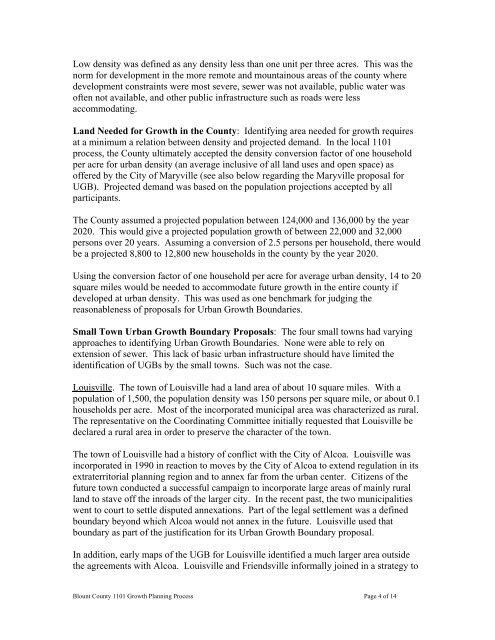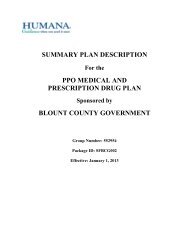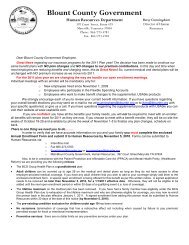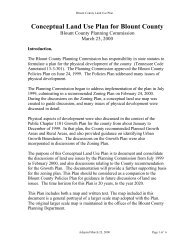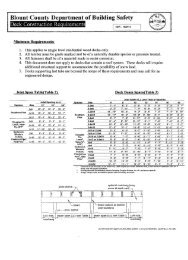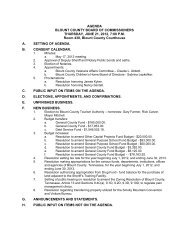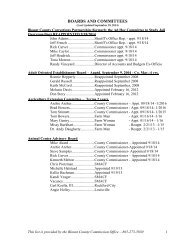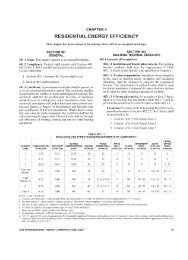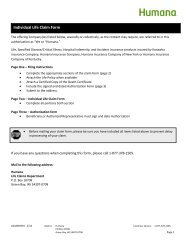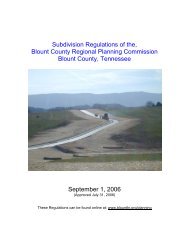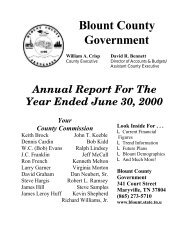Reflections on the 1101 Process in Blount County, Tennessee
Reflections on the 1101 Process in Blount County, Tennessee
Reflections on the 1101 Process in Blount County, Tennessee
Create successful ePaper yourself
Turn your PDF publications into a flip-book with our unique Google optimized e-Paper software.
Low density was def<strong>in</strong>ed as any density less than <strong>on</strong>e unit per three acres. This was <strong>the</strong>norm for development <strong>in</strong> <strong>the</strong> more remote and mounta<strong>in</strong>ous areas of <strong>the</strong> county wheredevelopment c<strong>on</strong>stra<strong>in</strong>ts were most severe, sewer was not available, public water wasoften not available, and o<strong>the</strong>r public <strong>in</strong>frastructure such as roads were lessaccommodat<strong>in</strong>g.Land Needed for Growth <strong>in</strong> <strong>the</strong> <strong>County</strong>: Identify<strong>in</strong>g area needed for growth requiresat a m<strong>in</strong>imum a relati<strong>on</strong> between density and projected demand. In <strong>the</strong> local <strong>1101</strong>process, <strong>the</strong> <strong>County</strong> ultimately accepted <strong>the</strong> density c<strong>on</strong>versi<strong>on</strong> factor of <strong>on</strong>e householdper acre for urban density (an average <strong>in</strong>clusive of all land uses and open space) asoffered by <strong>the</strong> City of Maryville (see also below regard<strong>in</strong>g <strong>the</strong> Maryville proposal forUGB). Projected demand was based <strong>on</strong> <strong>the</strong> populati<strong>on</strong> projecti<strong>on</strong>s accepted by allparticipants.The <strong>County</strong> assumed a projected populati<strong>on</strong> between 124,000 and 136,000 by <strong>the</strong> year2020. This would give a projected populati<strong>on</strong> growth of between 22,000 and 32,000pers<strong>on</strong>s over 20 years. Assum<strong>in</strong>g a c<strong>on</strong>versi<strong>on</strong> of 2.5 pers<strong>on</strong>s per household, <strong>the</strong>re wouldbe a projected 8,800 to 12,800 new households <strong>in</strong> <strong>the</strong> county by <strong>the</strong> year 2020.Us<strong>in</strong>g <strong>the</strong> c<strong>on</strong>versi<strong>on</strong> factor of <strong>on</strong>e household per acre for average urban density, 14 to 20square miles would be needed to accommodate future growth <strong>in</strong> <strong>the</strong> entire county ifdeveloped at urban density. This was used as <strong>on</strong>e benchmark for judg<strong>in</strong>g <strong>the</strong>reas<strong>on</strong>ableness of proposals for Urban Growth Boundaries.Small Town Urban Growth Boundary Proposals: The four small towns had vary<strong>in</strong>gapproaches to identify<strong>in</strong>g Urban Growth Boundaries. N<strong>on</strong>e were able to rely <strong>on</strong>extensi<strong>on</strong> of sewer. This lack of basic urban <strong>in</strong>frastructure should have limited <strong>the</strong>identificati<strong>on</strong> of UGBs by <strong>the</strong> small towns. Such was not <strong>the</strong> case.Louisville. The town of Louisville had a land area of about 10 square miles. With apopulati<strong>on</strong> of 1,500, <strong>the</strong> populati<strong>on</strong> density was 150 pers<strong>on</strong>s per square mile, or about 0.1households per acre. Most of <strong>the</strong> <strong>in</strong>corporated municipal area was characterized as rural.The representative <strong>on</strong> <strong>the</strong> Coord<strong>in</strong>at<strong>in</strong>g Committee <strong>in</strong>itially requested that Louisville bedeclared a rural area <strong>in</strong> order to preserve <strong>the</strong> character of <strong>the</strong> town.The town of Louisville had a history of c<strong>on</strong>flict with <strong>the</strong> City of Alcoa. Louisville was<strong>in</strong>corporated <strong>in</strong> 1990 <strong>in</strong> reacti<strong>on</strong> to moves by <strong>the</strong> City of Alcoa to extend regulati<strong>on</strong> <strong>in</strong> itsextraterritorial plann<strong>in</strong>g regi<strong>on</strong> and to annex far from <strong>the</strong> urban center. Citizens of <strong>the</strong>future town c<strong>on</strong>ducted a successful campaign to <strong>in</strong>corporate large areas of ma<strong>in</strong>ly ruralland to stave off <strong>the</strong> <strong>in</strong>roads of <strong>the</strong> larger city. In <strong>the</strong> recent past, <strong>the</strong> two municipalitieswent to court to settle disputed annexati<strong>on</strong>s. Part of <strong>the</strong> legal settlement was a def<strong>in</strong>edboundary bey<strong>on</strong>d which Alcoa would not annex <strong>in</strong> <strong>the</strong> future. Louisville used thatboundary as part of <strong>the</strong> justificati<strong>on</strong> for its Urban Growth Boundary proposal.In additi<strong>on</strong>, early maps of <strong>the</strong> UGB for Louisville identified a much larger area outside<strong>the</strong> agreements with Alcoa. Louisville and Friendsville <strong>in</strong>formally jo<strong>in</strong>ed <strong>in</strong> a strategy to<strong>Blount</strong> <strong>County</strong> <strong>1101</strong> Growth Plann<strong>in</strong>g <strong>Process</strong> Page 4 of 14


